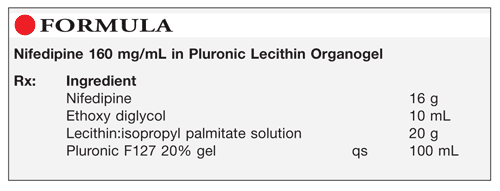US Pharm. 2011;36(12):39-40.

Method of Preparation: Calculate the quantity of each ingredient for the amount to be prepared. Accurately weigh or measure each ingredient. Note—The lecithin:isopropyl palmitate solution may be prepared by mixing 0.2 g sorbic acid, 50 g soy lecithin, and 50 g isopropyl palmitate. The Pluronic F127 solution may be prepared by mixing 0.2 g sorbic acid, 30 g Pluronic F127, and sufficient purified water to make 100 mL.
Mix the nifedipine with the ethoxy diglycol to form a smooth paste. Add the lecithin:isopropyl palmitate solution; mix well. Add sufficient Pluronic F127 20% gel to volume and mix thoroughly, using a mechanical shearing force. Package and label.
Use: Nifedipine topical preparations have been used to treat Raynaud’s phenomenon and progressive diabetic foot ulcers.
Packaging: Package in tight, light-resistant containers.
Labeling: Protect from light. Use only as directed. Keep out of the reach of children. Discard after ____ [time period].
Stability: No specific stability studies have been reported for this preparation. Nifedipine is highly photolabile and should be protected from light. A beyond-use date of 30 days may be used for this preparation.1
Quality Control: Quality-control assessment can include theoretical weight compared with actual weight, pH, specific gravity, active drug assay, color, texture–surface, texture–spatula spread, appearance, feel, rheologic properties, and physical observations.2
Discussion: Nifedipine is used orally to treat hypertension and angina pectoris and used topically to treat Raynaud’s phenomenon and progressive diabetic foot ulcers. When the preparation is rubbed onto the skin, it warms up and may become slightly more viscous and resistant to rubbing.3
Nifedipine (Adalat, Procardia, C17H18N2O6, MW 346.33) is a 1,4-dihydropyridine-derivative calcium channel blocker used in the management of Prinzmetal’s variant angina and chronic stable angina pectoris, hypertension, Raynaud’s phenomenon, preterm labor, and acute myocardial infarction. It occurs as a yellow powder that is affected by exposure to light. It is practically insoluble in water and soluble in alcohol.1,4
Ethoxy diglycol (diethylene glycol monoethyl ether, Carbitol, Transcutol, C6H14O3, CH2OHCH2OCH2CH2OC2H5, MW 134.20) occurs as a colorless liquid with a mild, pleasant odor. It is hygroscopic and is miscible with water and common organic solvents. It has a density of 1.0272 and is combustible. It is nonirritating and nonpenetrating when applied to human skin and is used as a solvent, solubilizer, and cosurfactant.5
Lecithin (egg lecithin, soybean lecithin, vegetable lecithin) describes a complex mixture of acetone-insoluble phosphatides in combination with triglycerides, fatty acids, and carbohydrates. The composition and physical properties vary depending upon the source of the lecithin and the degree of purification. Lecithin derived from vegetable sources has a bland or nutlike taste and varies from brown to light yellow, depending upon whether or not it is bleached. Lecithin is practically insoluble in water, polar solvents, and cold vegetable and animal oils; when mixed with water, it hydrates to form emulsions. It should be stored in well-closed containers and be protected from light.6
Isopropyl palmitate (C19H38O2, MW 298.51) is a colorless, mobile liquid with a slight odor. It is used as an emollient, oleaginous vehicle, and solvent and has good spreading characteristics. It is soluble in acetone, castor oil, cottonseed oil, alcohol, and mineral oil. It is insoluble in water, glycerin, and propylene glycol. It is resistant to oxidation and hydrolysis and does not become rancid. It should be stored in well-closed containers and protected from light.7
Pluronic F127 (poloxamer) is one of a series of closely related block copolymers of ethylene oxide and propylene oxide that are used as emulsifying, solubilizing, and wetting agents. They are available in different grades, either liquids or solids, with average molecular weight ranging from 2,090 to 14,600. The pH of a 2.5% w/v aqueous solution ranges from 6.0 to 7.4. The poloxamers are stable and aqueous solutions are stable in the presence of acids, alkalis, and metal ions, but the aqueous solutions support mold growth. Poloxamer 407 (Pluronic F127) is generally available in powdered form. It may be odorless or have a very mild odor. It melts at about 56°C, and it is freely soluble in water, alcohol, and isopropyl alcohol.8
REFERENCES
1. USP Pharmacists’ Pharmacopeia. 2nd ed. Rockville, MD: US Pharmacopeial Convention Inc; 2008:408-413,775-779,1450.
2. Allen LV Jr. Standard operating procedure for performing physical quality assessment of ointments/creams/gels. IJPC. 1998;2:308-309.
3. Lazarus RJ, Onor A, Hameed K. Nifedipine and a diabetic ulcer. Ann Intern Med. 1983;98:414.
4. McEvoy GK. AHFS Drug Information 2011. Bethesda, MD: American Society of Health-System Pharmacists; 2011:1945-1952.
5. Ash M, Ash I. Handbook of Pharmaceutical Additives. Brookfield, VT: Gower Publishing Ltd; 1995:484.
6. Sheng JJ. Lecithin. In: Rowe RC, Sheskey PJ, Quinn ME, eds. Handbook of Pharmaceutical Excipients. 6th ed. London, England: Pharmaceutical Press; 2009:385-387.
7. Taylor AK. Isopropyl palmitate. In: Rowe RC, Sheskey PJ, Quinn ME, eds. Handbook of Pharmaceutical Excipients. 6th ed. London, England: Pharmaceutical Press; 2009:350-351.
8. Collett JH. Poloxamer. In: Rowe RC, Sheskey PJ, Quinn ME, eds. Handbook of Pharmaceutical Excipients. 6th ed. London, England: Pharmaceutical Press; 2009:506-509.
To comment on this article, contact rdavidson@uspharmacist.com.





